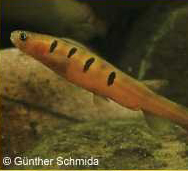 The last article in our Endangered Species series is dedicated to the Barred Galaxias, an extremely rare, threatened fish. Pre-Black Saturday it existed in the small stream at Gallipoli Park in the heart of Marysville and now its future in this town is unknown.
The last article in our Endangered Species series is dedicated to the Barred Galaxias, an extremely rare, threatened fish. Pre-Black Saturday it existed in the small stream at Gallipoli Park in the heart of Marysville and now its future in this town is unknown.
Discovered in 1998 at this Marysville stream, from a population of approximately 40, only six Barred Galaxias were saved following Black Saturday and are currently in a cool room in tanks. This is an amazing little fish, indigenous to the area and on unfortunately now on the threat of extinction.
The Barred Galaxias (Galaxias fuscus) is a bright orange fish growing up to 15 centimetres long, but commonly reaching just 7 to 9 centimetres. It has up to 10 vertical dark bars on its side with at least one to four usually very distinct, clear to reddish-brown fins.
Trout directly compete with this species for living space and food and eat their tadpoles. The Barred Galaxias were protected from trout in the Marysville stream by a barrier which was singed in the fire. They are unable to return to their home due to drought and the unsuitability of this barrier.
The Barred Galaxias habitat is small, shallow, gravel-bottomed upland streams in mountainous which are typically cool and well oxygenated. Barred Galaxias is endemic to Victoria and is only known from one population in 12 streams in the upper Goulburn River catchment:
• Stanley, Bindaree and Falls Creeks near Mount Stirling
• the upper Rubicon River and the upper Torbreck River near Lake Mountain
• Godfrey, Raspberry, Perkins and Pheasant Creeks and Brewery Gully near Woods Point
• in Gallipoli Park in Marysville (currently not housed)
• the upper Taggerty River, Keppel Hut Creek
Most of the remaining populations are geographically isolated from each other by the presence of trout and it’s unlikely that any gene flow exists between these populations.
At least five populations are presumed to have become extinct since its description in 1936, disappearing from Mountain Creek near Kinglake, Whitehouse Creek near Lake Mountain, Quartz Creek and the lower Rubicon River near Rubicon, and Gaffneys Creek near Woods Point.
The Barred Galaxias is non-migratory, completing its whole life cycle in freshwater. Consequently, this species has little ability to recolonise areas after localised extinctions Trout-free zones have been established, however, to date there has been limited movement of the fish into these zones. This is possibly due to the extremely small source population sizes, the low reproductive or recruitment rates, and potential small natural movement patterns.
Very limited work has been conducted on aspects of the ecology and life history of the Barred Galaxias, after initial studies deeming it to be separate, was classified as a sub-species of the Mountain Galaxias. It was only in 1989 that Barred Galaxias was reinstated as a distinct species.
In 1995, Department of Sustainability and Environment (DSE) produced an ‘Action Statement’ for the Barred Galaxias, which remains current today. It’s designed to protect and ensure the Barred Galaxias’s long-term survival.
Photo: © Gunther Schmida

